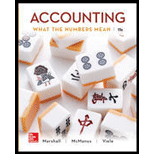
Concept explainers
Concept Introduction:
Accounting equation represents the mathematical relationship between assets, liabilities and equity. According to this equation, assets are equal to the sum of liabilities and equity. The formal for basic accounting equation is as follows:
Stockholder's Equity:
To Calculate:
The Total Stockholder's Equity at the end of the year
Answer to Problem 2.1ME
The Total Stockholder's Equity at the end of the year is $54,000
Explanation of Solution
The Total Stockholder's Equity at the end of the year is calculated as follows:
| Beginning Total Assets (A) | $96,000 |
| Beginning Total Liabilities (B) | $54,000 |
| Beginning Stockholder's Equity (C) =(A-B) | $42,000 |
| Net Income (D) | $16,000 |
| Dividends (E) | $ 4,000 |
| Ending Stockholder's Equity (C+D-E) | $54,000 |
Want to see more full solutions like this?
Chapter 2 Solutions
Accounting: What the Numbers Mean
- The following data were taken from the accounts of Burnside Bedknobs, a retail business. Determine the gross profit. Sales Sales returns and allowances Sales discounts $1,15,200 1,100 400 Merchandise inventory, January 1 30,000 Purchases during the period 1,00,000 Purchases returns and allowances during the period 2,000 Purchases discounts taken during the period 2,800 Freight-in on merchandise purchased during the period 1,500 Merchandise inventory, December 31 50,000arrow_forwardI need help solving this general accounting question with the proper methodology.arrow_forwardPlease provide the solution to this general accounting question using proper accounting principles.arrow_forward
- Please show me the correct approach to solving this financial accounting question with proper techniques.arrow_forwardCan you solve this accounting question with accurate accounting calculations?arrow_forwardCan you solve this general accounting question with the appropriate accounting analysis techniques?arrow_forward

 AccountingAccountingISBN:9781337272094Author:WARREN, Carl S., Reeve, James M., Duchac, Jonathan E.Publisher:Cengage Learning,
AccountingAccountingISBN:9781337272094Author:WARREN, Carl S., Reeve, James M., Duchac, Jonathan E.Publisher:Cengage Learning, Accounting Information SystemsAccountingISBN:9781337619202Author:Hall, James A.Publisher:Cengage Learning,
Accounting Information SystemsAccountingISBN:9781337619202Author:Hall, James A.Publisher:Cengage Learning, Horngren's Cost Accounting: A Managerial Emphasis...AccountingISBN:9780134475585Author:Srikant M. Datar, Madhav V. RajanPublisher:PEARSON
Horngren's Cost Accounting: A Managerial Emphasis...AccountingISBN:9780134475585Author:Srikant M. Datar, Madhav V. RajanPublisher:PEARSON Intermediate AccountingAccountingISBN:9781259722660Author:J. David Spiceland, Mark W. Nelson, Wayne M ThomasPublisher:McGraw-Hill Education
Intermediate AccountingAccountingISBN:9781259722660Author:J. David Spiceland, Mark W. Nelson, Wayne M ThomasPublisher:McGraw-Hill Education Financial and Managerial AccountingAccountingISBN:9781259726705Author:John J Wild, Ken W. Shaw, Barbara Chiappetta Fundamental Accounting PrinciplesPublisher:McGraw-Hill Education
Financial and Managerial AccountingAccountingISBN:9781259726705Author:John J Wild, Ken W. Shaw, Barbara Chiappetta Fundamental Accounting PrinciplesPublisher:McGraw-Hill Education





